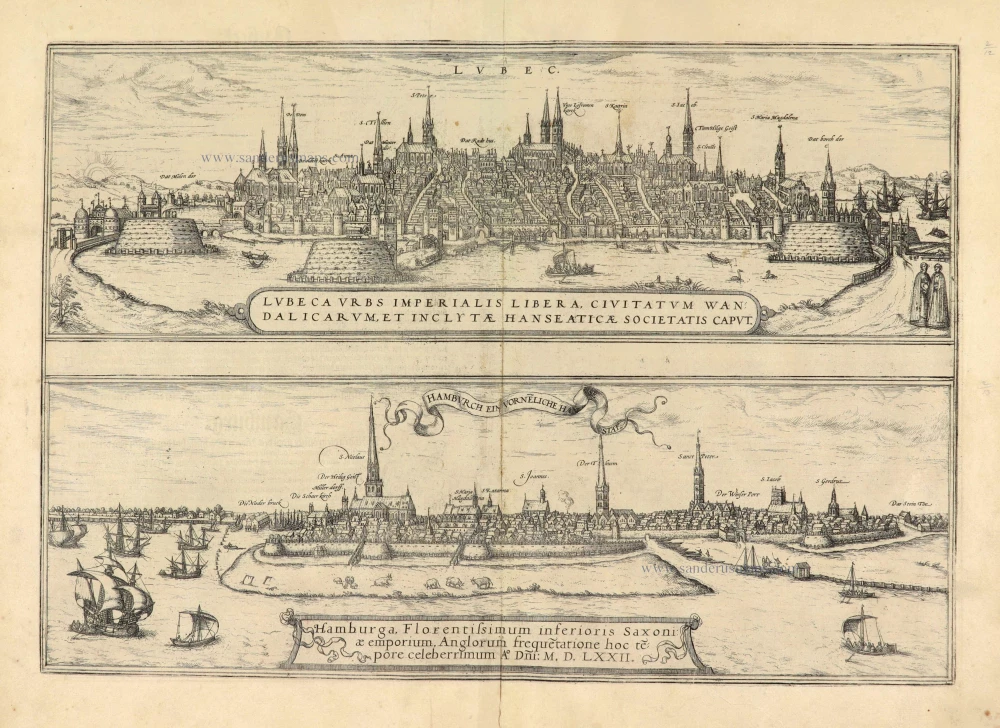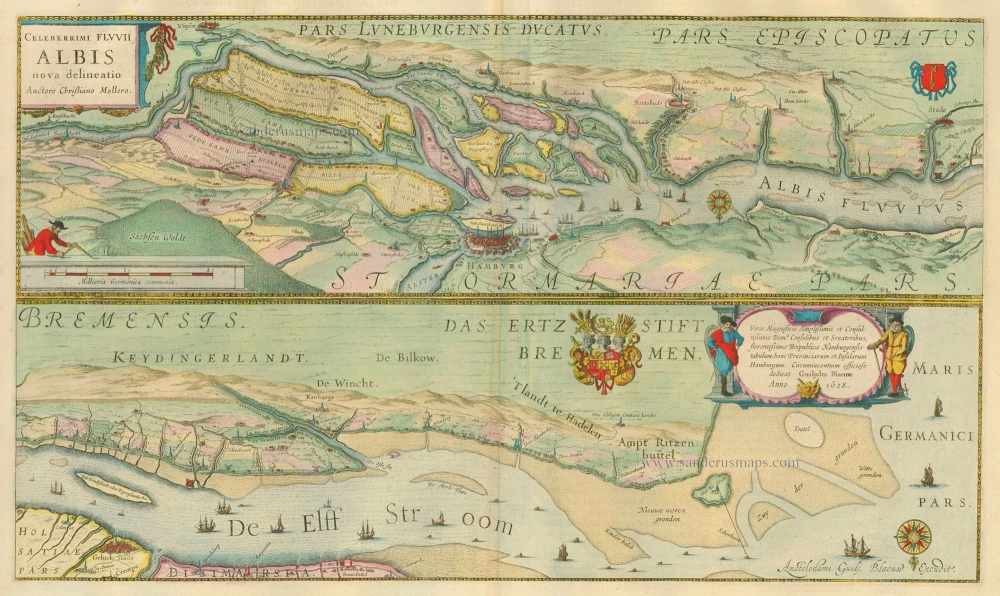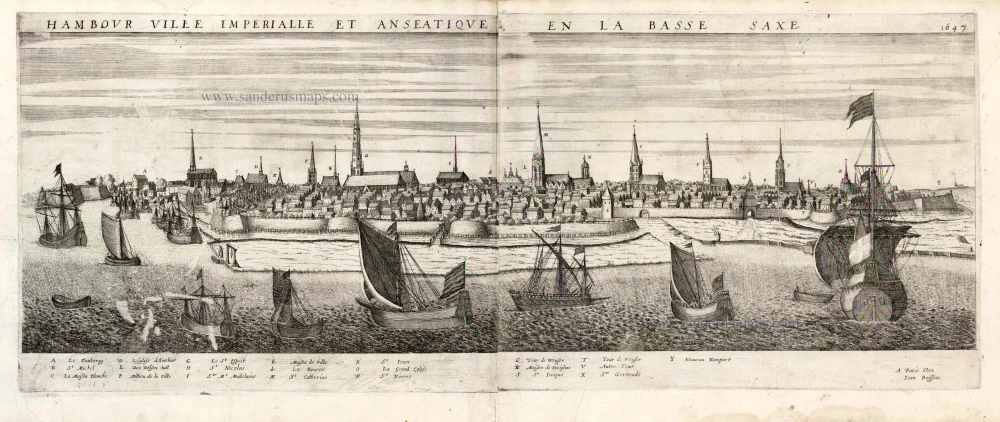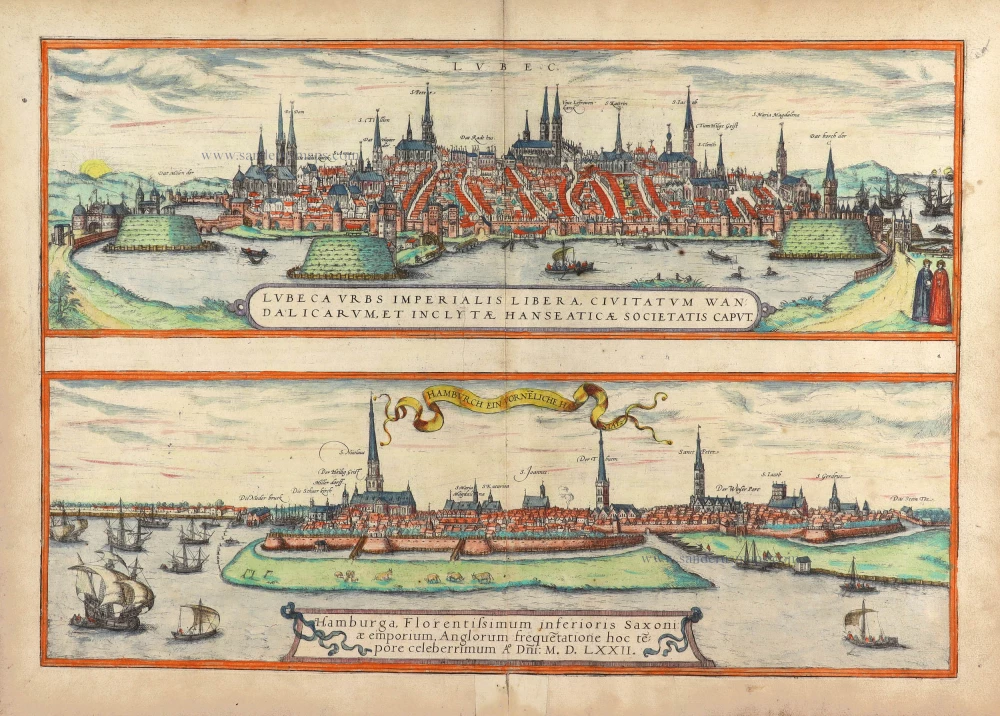Lubeck - Hamburg, by Georg Braun & Frans Hogenberg. 1574
LÜBECK
TRANSLATION OF CARTOUCHE TEXT: The Free Imperial City of Lübeck, capital of the Vandals and the world-famous Hanseatic League.
COMMENTARY BY BRAUN: "Lübeck is well fortified in our own day with massive bulwarks, which lie on strong stakes in the water. It possesses two long streets, which are crossed by the others and which lead down to the Rivers Trave and Wakenitz; the streets are very clean, because all the dirt runs off into the rivers. Lübeck also has handsome churches with tall towers that are roofed in copper and lead and have gold spires. The water is conveyed from the river to a high tower by an ingeniously designed mill and from there runs via the ground and channels into the town houses, so that an unknowing observer might think it came from a spring."
The view shows the "City of Seven Spires" on the Baltic Sea seen from the west across the inland harbour, with the city gates - the Holstentor, left, Molentor and Burgtor, right - and the spires of its seven Gothic red-brick churches, all of which evolved out of existing Romanesque churches. Rising magnificently on the left is Lübeck's Gothic cathedral (De Dom). Further right lies the church of St Giles (S. Tillien), then the imperial church of St Peter (S. Petri) and the town Hall. St Mary's (Unse Lefrowen Karck) served the merchants, city council and people of Lübeck and is considered the mother church of red-brick Gothic architecture in northern Germany: it would provide the model for some 70 churches in the Baltic region. On the far right, finally, is the church of St. James (S. Iakob), dedicated to the patron saint of sailors and fishermen.
HAMBURG
CARTOUCHE: Hamburg, flourishing centre of trade in Lower Saxony, in our times particularly well known for its many English visitors. In the year of our Lord 1572.
COMMENTARY BY BRAUN: "Hamburg is ten miles from Lübeck, is abundantly surrounded by water and therefore is best placed to conduct international trade; for this reason one sees many English here, who no longer travel to Antwerp, but transact their business here. As far as the city walls, the moats, the embankments and the wealth of the inhabitants is concerned, I have seen nothing more beautiful or better fortified than Hamburg. There are very splendid buildings here that are equipped with water pipes. For want of wine, the Hamburgers brew beer, which is drunk with great pleasure not only in the city but in all the towns of Lower Saxony; it is quit astonishing to see how the people get drunk on beer: it is even the case that the one who can drink the most receives the most praise and admiration. [...]"
This view, showing the city from a low vantage point, reveals its rural character. Left stands the 153-m-high tower of the chruch of St Nicholas, which was completed in 1517 in the north-German brick-Gothic style. To the right is the spire of St Peter's. The modern city landmark, the Hamburger Michel, was finished in 1786 as the tower of the Barocque church of St Michael. After the Emperor Frederick I Barbarossa granted the city port rights in 1189 and, therefore, tax exemption on trading with the entire Lower Elbe region, Hamburg grew into a vibrant commercial hub. Boasting up to 600 breweries, the city was the purveyor of beer to the Hanseatic League. (Taschen)
Braun G. & Hogenberg F. and the Civitates Orbis Terrarum.
The Civitates Orbis Terrarum, also known as the 'Braun & Hogenberg', is a six-volume town atlas and the most excellent book of town views and plans ever published: 363 engravings, sometimes beautifully coloured. It was one of the best-selling works in the last quarter of the 16th century. Georg Braun, a skilled writer, wrote the text accompanying the plans and views on the verso. Many plates were engraved after the original drawings of a professional artist, Joris Hoefnagel (1542-1600). The first volume was published in Latin in 1572 and the sixth in 1617. Frans Hogenberg, a talented engraver, created the tables for volumes I through IV, and Simon van den Neuwel made those for volumes V and VI. Other contributors were cartographers Daniel Freese and Heinrich Rantzau, who provided valuable geographical information. Works by Jacob van Deventer, Sebastian Münster, and Johannes Stumpf were also used as references. Translations appeared in German and French, making the atlas accessible to a broader audience.
Since its original publication of volume 1 in 1572, the Civitates Orbis Terrarum has left an indelible mark on the history of cartography. Seven more editions followed the first volume in 1575, 1577, 1582, 1588, 1593, 1599, and 1612. Vol.2, initially released in 1575, saw subsequent editions in 1597 and 1612. The subsequent volumes, each a treasure trove of historical insights, graced the world in 1581, 1588, 1593, 1599, and 1606. The German translation of the first volume, a testament to its widespread appeal, debuted in 1574, followed by the French edition in 1575.
Several printers were involved: Theodor Graminaeus, Heinrich von Aich, Gottfried von Kempen, Johannis Sinniger, Bertram Buchholtz, and Peter von Brachel, all of whom worked in Cologne.
Georg Braun (1541-1622)
Georg Braun, the author of the text accompanying the plans and views in the Civitates Orbis Terrarum, was born in Cologne in 1541. After his studies in Cologne, he entered the Jesuit Order as a novice, indicating his commitment to learning and intellectual pursuits. In 1561, he obtained his bachelor's degree; in 1562, he received his Magister Artium, further demonstrating his academic achievements. Although he left the Jesuit Order, he continued his studies in theology, gaining a licentiate in theology. His theological background likely influenced the content and tone of the text in the Civitates Orbis Terrarum, adding a unique perspective to the work.
Frans Hogenberg (1535-1590)
Frans Hogenberg was a Flemish and German painter, engraver, and mapmaker. He was born in Mechelen as the son of Nicolaas Hogenberg.
By the end of the 1560s, Frans Hogenberg was employed upon Abraham Ortelius's Theatrum Orbis Terrarum, published in 1570; he is named an engraver of numerous maps. In 1568, he was banned from Antwerp by the Duke of Alva and travelled to London, where he stayed a few years before emigrating to Cologne. He immediately embarked on his two most important works, the Civitates, published in 1572 and the Geschichtsblätter, which appeared in several series from 1569 until about 1587.
Thanks to large-scale projects like the Geschichtsblätter and the Civitates, Hogenberg's social circumstances improved with each passing year. He died as a wealthy man in Cologne in 1590.
Lubeca Urbs Imperialis Libera, Civitatum Wandalicarum, et Inclytae Hanseaticae Societatis Caput [on sheet with] Hamburga, Florentissimum Inferioris Saxoniae Emporium, Anglorum frequetatione hoc tepore celeberrimum A° Dñi: M.D.LXXII.
Item Number: 28037 Authenticity Guarantee
Category: Antique maps > Europe > Germany - Cities
Old, antique bird’s-eye view plan of Lubeck - Hamburg, by Georg Braun & Frans Hogenberg.
Title: Lubeca Urbs Imperialis Libera, Civitatum Wandalicarum, et Inclytae Hanseaticae Societatis Caput [on sheet with] Hamburga, Florentissimum Inferioris Saxoniae Emporium, Anglorum frequetatione hoc tepore celeberrimum A° Dñi: M.D.LXXII.
Date of the first edition: 1572.
Date of this map: 1574.
Copper engraving, printed on paper.
Size (not including margins): 340 x 475mm (13.39 x 18.7 inches).
Verso: German text.
Condition: Excellent.
Condition Rating: A+.
References: Van der Krogt 4, 2482; Taschen, Br. Hog., p.86; Fauser, #8054 & #5358
From: Beschreibung und Contrafactur der Vornembster Stät der Welt. Köln, Heinrich von Ach, 1574. (Van der Krogt 4, 41:2.1)
LÜBECK
TRANSLATION OF CARTOUCHE TEXT: The Free Imperial City of Lübeck, capital of the Vandals and the world-famous Hanseatic League.
COMMENTARY BY BRAUN: "Lübeck is well fortified in our own day with massive bulwarks, which lie on strong stakes in the water. It possesses two long streets, which are crossed by the others and which lead down to the Rivers Trave and Wakenitz; the streets are very clean, because all the dirt runs off into the rivers. Lübeck also has handsome churches with tall towers that are roofed in copper and lead and have gold spires. The water is conveyed from the river to a high tower by an ingeniously designed mill and from there runs via the ground and channels into the town houses, so that an unknowing observer might think it came from a spring."
The view shows the "City of Seven Spires" on the Baltic Sea seen from the west across the inland harbour, with the city gates - the Holstentor, left, Molentor and Burgtor, right - and the spires of its seven Gothic red-brick churches, all of which evolved out of existing Romanesque churches. Rising magnificently on the left is Lübeck's Gothic cathedral (De Dom). Further right lies the church of St Giles (S. Tillien), then the imperial church of St Peter (S. Petri) and the town Hall. St Mary's (Unse Lefrowen Karck) served the merchants, city council and people of Lübeck and is considered the mother church of red-brick Gothic architecture in northern Germany: it would provide the model for some 70 churches in the Baltic region. On the far right, finally, is the church of St. James (S. Iakob), dedicated to the patron saint of sailors and fishermen.
HAMBURG
CARTOUCHE: Hamburg, flourishing centre of trade in Lower Saxony, in our times particularly well known for its many English visitors. In the year of our Lord 1572.
COMMENTARY BY BRAUN: "Hamburg is ten miles from Lübeck, is abundantly surrounded by water and therefore is best placed to conduct international trade; for this reason one sees many English here, who no longer travel to Antwerp, but transact their business here. As far as the city walls, the moats, the embankments and the wealth of the inhabitants is concerned, I have seen nothing more beautiful or better fortified than Hamburg. There are very splendid buildings here that are equipped with water pipes. For want of wine, the Hamburgers brew beer, which is drunk with great pleasure not only in the city but in all the towns of Lower Saxony; it is quit astonishing to see how the people get drunk on beer: it is even the case that the one who can drink the most receives the most praise and admiration. [...]"
This view, showing the city from a low vantage point, reveals its rural character. Left stands the 153-m-high tower of the chruch of St Nicholas, which was completed in 1517 in the north-German brick-Gothic style. To the right is the spire of St Peter's. The modern city landmark, the Hamburger Michel, was finished in 1786 as the tower of the Barocque church of St Michael. After the Emperor Frederick I Barbarossa granted the city port rights in 1189 and, therefore, tax exemption on trading with the entire Lower Elbe region, Hamburg grew into a vibrant commercial hub. Boasting up to 600 breweries, the city was the purveyor of beer to the Hanseatic League. (Taschen)
Braun G. & Hogenberg F. and the Civitates Orbis Terrarum.
The Civitates Orbis Terrarum, also known as the 'Braun & Hogenberg', is a six-volume town atlas and the most excellent book of town views and plans ever published: 363 engravings, sometimes beautifully coloured. It was one of the best-selling works in the last quarter of the 16th century. Georg Braun, a skilled writer, wrote the text accompanying the plans and views on the verso. Many plates were engraved after the original drawings of a professional artist, Joris Hoefnagel (1542-1600). The first volume was published in Latin in 1572 and the sixth in 1617. Frans Hogenberg, a talented engraver, created the tables for volumes I through IV, and Simon van den Neuwel made those for volumes V and VI. Other contributors were cartographers Daniel Freese and Heinrich Rantzau, who provided valuable geographical information. Works by Jacob van Deventer, Sebastian Münster, and Johannes Stumpf were also used as references. Translations appeared in German and French, making the atlas accessible to a broader audience.
Since its original publication of volume 1 in 1572, the Civitates Orbis Terrarum has left an indelible mark on the history of cartography. Seven more editions followed the first volume in 1575, 1577, 1582, 1588, 1593, 1599, and 1612. Vol.2, initially released in 1575, saw subsequent editions in 1597 and 1612. The subsequent volumes, each a treasure trove of historical insights, graced the world in 1581, 1588, 1593, 1599, and 1606. The German translation of the first volume, a testament to its widespread appeal, debuted in 1574, followed by the French edition in 1575.
Several printers were involved: Theodor Graminaeus, Heinrich von Aich, Gottfried von Kempen, Johannis Sinniger, Bertram Buchholtz, and Peter von Brachel, all of whom worked in Cologne.
Georg Braun (1541-1622)
Georg Braun, the author of the text accompanying the plans and views in the Civitates Orbis Terrarum, was born in Cologne in 1541. After his studies in Cologne, he entered the Jesuit Order as a novice, indicating his commitment to learning and intellectual pursuits. In 1561, he obtained his bachelor's degree; in 1562, he received his Magister Artium, further demonstrating his academic achievements. Although he left the Jesuit Order, he continued his studies in theology, gaining a licentiate in theology. His theological background likely influenced the content and tone of the text in the Civitates Orbis Terrarum, adding a unique perspective to the work.
Frans Hogenberg (1535-1590)
Frans Hogenberg was a Flemish and German painter, engraver, and mapmaker. He was born in Mechelen as the son of Nicolaas Hogenberg.
By the end of the 1560s, Frans Hogenberg was employed upon Abraham Ortelius's Theatrum Orbis Terrarum, published in 1570; he is named an engraver of numerous maps. In 1568, he was banned from Antwerp by the Duke of Alva and travelled to London, where he stayed a few years before emigrating to Cologne. He immediately embarked on his two most important works, the Civitates, published in 1572 and the Geschichtsblätter, which appeared in several series from 1569 until about 1587.
Thanks to large-scale projects like the Geschichtsblätter and the Civitates, Hogenberg's social circumstances improved with each passing year. He died as a wealthy man in Cologne in 1590.





